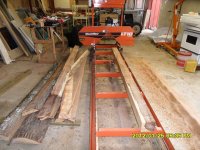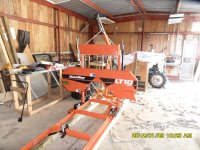This is the process I used on my 670D:
1. with throttle OFF, crank a cold engine for several seconds, until internal bearings and crankshaft journals become fully lubricated by the oil pump.
2. engage glow plugs by turning ignition key fully counterclockwise (backward) for 30 seconds, or longer if air temps are lower than 10 degrees F. There is a glow plug indicator found on the right side of dash, under the throttle lever. It is beneath a small, chromed convex disk with little holes in it. When you see a glowing filament through the holes (the longer you pre-heat the glow plugs, the brighter it will glow), you are ready to crank the engine for the second time. It will not begin to glow instantly, but will take at least 15 seconds before you begin to see the filament glowing. In bright sunlight, it is not easy to see it glowing. If you cannot see the indicator glowing after 30 seconds, you have may a problem with the indicator.
3. advance the hand throttle just enough to provide a sufficient amount of fuel to start the engine and continue running at approximately 800 rpm.
4. depress and hold the foot throttle fully and rotate the ignition key (which you have kept at the "heat glow plugs" position while advancing throttle to the 800 rpm position) to the fully counterclockwise "crank" position. Crank the starter while continuing to depress the foot throttle until the engine is firing on all 4 cylinders, which shouldn't take long at all. The engine should start within a very few revolutions. Once it starts, release the foot throttle to prevent over-revving! If you have to crank the engine for more than five seconds and it still does not start.....you have a problem. Either two or more of the glow plugs are not functional, or you may have a low compression issue. OR, you may have a problem with poor or gelling fuel if the air temp is hovering at zero degrees or lower. Always use a winter blend of diesel in temps below freezing. In the case of cold temperatures, if you have the capability of pre-heating the engine with a block or tank heater for an hour, it will help immensely. If you have no engine heater, you may CAREFULLY heat the engine with an external heat source such as an electric portable heater positioned a foot or two to the side of the engine. If your heater is large, i.e. over 1500 watts, watch carefully to not scorch the paint on your tractor! Or, a portable fuel oil heater (knipco type) can also be used if placed several feet away from the side of the engine. If you do use such a heater, capable of producing 100,000+ BTU or more, DO NOT leave your tractor out of sight!! Heating the engine with one of these powerful heaters has the potential to damage the paint, or ignite anything combustible that may be clinging to the surface of the tractor, and possibly worse! BE CAREFUL if choosing to heat up your engine with a large, powerful external heat source! Don't venture away from your tractor for long if you are using a powerful heat source!!
5. If your tractor starts promptly using the above instructions, let it warm up fully at 1200 rpm for several minutes (10 or more) before using it in cold conditions. The colder it is, the longer you need to warm it up.
6. As others have stated, it is definitely NOT advisable to use ether for giving the tractor an extra boost in starting. Ether is an extreme solvent that will instantly clean off the internal walls of cylinders and pistons of the oil film which is necessary to lubricate them. Starting an engine with dry cylinders is a recipe for trouble. Don't risk it.
7. Enjoy your 670, it is a terrific little tractor.
Vvm


